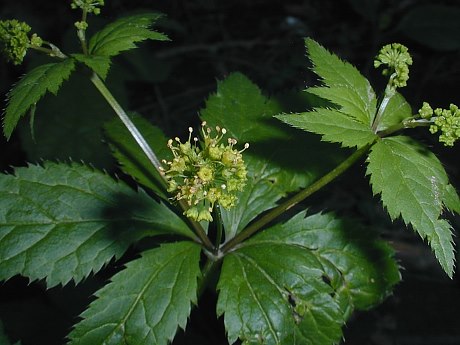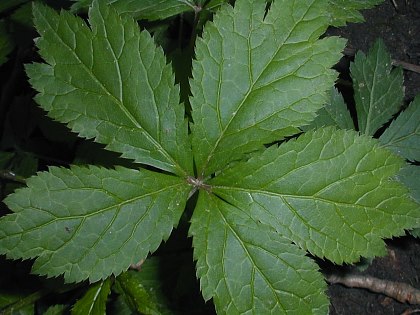Description: This herbaceous perennial plant is 1–2½' tall, branching occasionally. The stems are light green to pale red or purple, glabrous, and veined. The leaves are alternate, opposite, or basal. The basal and lower leaves are palmately divided into 5 leaflets; these compound leaves span up to 5" long and across, and their petioles are up to 6" long. The middle to upper leaves are trifoliate with 3 leaflets; they are smaller in size and usually sessile. The leaflets are up to 2½" long and 1" across; they are oblanceolate, elliptic, obovate, or ovate in shape. Each leaflet is shallowly cleft and coarsely serrated along the margins; the bottom of each leaflet is wedge-shaped and sessile. Both the leaves and their petioles (if any) are glabrous.

Each upper stem
terminates in 1-5 umbels of flowers. Each umbel is globoid or
semi-globoid and spans up to ½" across; it consists of 20-60 tiny
flowers and their pedicels. The stalk (or ray) of each umbel is up to
1" long. Each umbel has 1-3 perfect flowers (male & female
reproductive organs), while the remaining flowers are staminate (male
only). Whether perfect or staminate, each flower has a short green
calyx with 5 ovate teeth, 5 greenish yellow petals that are obcordate
in shape, and 5 exerted stamens with conspicuous anthers. The anthers
are initially yellow, but they later become brown. In addition, each
perfect flower has a bristly globoid ovary and a pair of long recurved
styles. These styles are longer than the bristles of the ovary. The
blooming period occurs from late spring to mid-summer and lasts about
2-3 weeks. Each bur-like fruit contains a pair of seeds. The root
system is fibrous. Colonies often develop in favorable habitats.
Cultivation:
This plant is typically found in partial sun to medium shade, moist to
slightly dry conditions, and fertile loamy soil. While the flowers are
not very showy, it can be used as a ground cover in shaded areas.
Range & Habitat:
Common Black Snakeroot is occasional to common in most areas of
Illinois (see Distribution
Map), where it is native. Habitats include deciduous
woodlands, areas along
woodland paths, thickets, shaded seeps, and fence rows that are
overgrown with woody vegetation. Sometimes this species invades shaded
areas of gardens. Tolerance to degradation of woodland habitat is above
average.

Faunal
Associations:
The nectar and pollen of the flowers attract small bees (Halictid
& Andrenid) and various flies. White-Tailed Deer and other
mammalian herbivores avoid consumption of the foliage because of its
bitter taste. The small prickly fruits can cling to the fur of mammals,
feathers of birds, and clothing of humans; this helps to distribute the
seeds to new locations.
Photographic Location:
A mesic area of Busey Woods in Urbana, Illinois.
Comments:
Common Black Snakeroot can be distinguished from other Sanicula
spp. (Black Snakeroots) by its greenish yellow flowers. Other
Black Snakeroots have greenish white flowers. The recurved styles of
Common Black Snakeroot are longer than the prickles of the ovary, while
other Black Snakeroots have more erect styles that are shorter or the
same length as the prickles of their ovaries. The common name (Black
Snakeroot) probably refers to the pioneer belief that the bitter roots
were useful in treating snake bites, although this is highly doubtful.
Another scientific name of Common Black Snakeroot is Sanicula
gregaria, which resulted in the common name, 'Clustered Black
Snakeroot.'